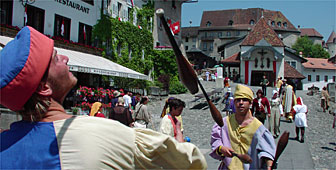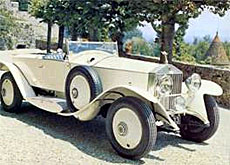Castle boasts role in shaping European history

The battle of Grandson helped to shape modern Europe, more so than any of the other 117 castles in canton Vaud.
And the past comes alive during a visit to the castle on the southwestern shore of Lake Neuchâtel.
The key date in Grandson’s history was March 2, 1476, the day when the might and splendour of Burgundy was forced to flee by the fledgling Swiss confederation.
The Battle of Grandson was the first of three major battles between Charles of Burgundy – known as le Téméraire or the Reckless – and the then largely Germanic Swiss, who were encouraged by the other European powers to block Charles’s expansionism.
Swiss military might
At Charles’s disposal were Burgundian cavalry, the finest mercenary foot soldiers in Europe and the latest in modern artillery.
After besieging the castle for three days, he forced the surrender of the Swiss garrison.
But instead of releasing the 412 captured confederates as promised, he had them all executed. Enraged, the Swiss army, without waiting for their commanders, raced into battle.
The clash – depicted at the castle with model lead soldiers – was a success for the Swiss pikemen in their defensive squares, and a disaster for the Burgundian cavalry.
“The battle was over almost before it had started. Of 40,000 men on the battlefield, just 600 died,” explains Jean-Jacques Gudel, vice-president of the Friends of the Castle association.
Nevertheless, the battle – along with the two that followed – at Murten and Nancy – had important political and historical consequences.
“It established the pre-eminence of Swiss soldiers, who became renowned mercenaries. It also established the importance of infantry and artillery, and the decline of cavalry,” Gudel says.
Politically, the collapse of Burgundy, and the capture of its territories by France and Switzerland, helped to shape the borders of modern Europe.
Booty
In his haste to escape Grandson, Charles left behind not only 400 canons, but also a fabulously extravagant booty – tapestries, jewels and standards that now adorn many a Swiss museum.
One of the most prized acquisitions was Charles’s pearl and jewel encrusted gold felt hat, which was pilfered by troops from Basel.
A replica – crafted from a detailed drawing made before the hat was destroyed and the precious elements sold off – is on display in the castle’s “booty room”.
Here, there is also a copy of Charles’s battlefield tent and an array of armour and fearsome weaponry.
These are among the attractions you would expect to find in a medieval castle – a torture and execution chamber, a chapel, a fine array of arms and armour, a walk along the ramparts and watch-towers.
But even if recent owners have made their own not entirely authentic repairs, history seems to be engrained in Grandson’s walls, and the past is brought back to life twice a year at the castle.
Every December, there is a colourful Christmas craft market, and over one weekend in August, it stages a medieval festival.
Members of the public are lent period costumes, while hurdy-gurdy players, jugglers, archers and spit-roast wild boar give the party the right atmosphere.
Steeped in history
“The food, the music and the customs help to emphasise the castle’s place in history,” says Gudel.
This is a region steeped in history. The lowering of the level of the lake during the 19th Century revealed bronze-age dwellings.
The castle itself dates back to the 11th Century, and one side of the square keep still forms part of one of the castle’s walls.
The castle has even had a long association with Britain which began in the 13th century.
The lord of Grandson, Othon I, reputedly saved King Edward the First’s life.
Members of the Grandson family moved to England, anglicised the name and by the 1330s, John de Grandisson was Bishop of Exeter.
swissinfo, Roy Probert
Battle of Grandson took place on March 2, 1476.
40,000 men took part in fighting.
Charles the Bold left behind fabulous booty.
Expansion plans of Burgundy came to end with two further defeats to Swiss forces in Murten and Nancy.
Of the 117 castles in canton Vaud, Grandson is the most significant.
It was the scene of the Battle of Grandson in 1476, which pitted Swiss soldiers against the forces of Charles the Bold of Burgundy.
The castle is now a museum with many displays and treasures recalling the famous battle.

In compliance with the JTI standards
More: SWI swissinfo.ch certified by the Journalism Trust Initiative











You can find an overview of ongoing debates with our journalists here . Please join us!
If you want to start a conversation about a topic raised in this article or want to report factual errors, email us at english@swissinfo.ch.